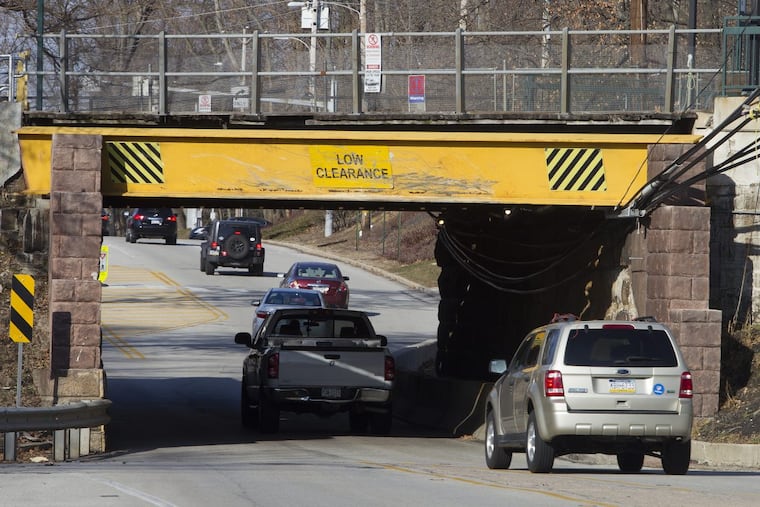'This is nuts': Dozens of trucks have slammed into the same overpass over the years
Since 2008, at least 43 trucks have struck that bridge. In the past two months alone, at least three have gotten stuck there, an influx that has officials frustrated and scrambling for solutions.

It was around 9 a.m. Dec. 22 when the truck got stuck underneath the overpass, closing a section of King of Prussia Road in Radnor for hours as crews worked to extricate the vehicle.
For drivers heading to work or last-minute Christmas shopping, it was a hassle. For authorities and neighbors, it felt like déjà vu.
Since 2008, at least 43 trucks have struck that bridge, which sits between Matsonford and Radnor Chester Roads and over which SEPTA and Amtrak trains run. In the last two months alone, at least three have gotten stuck there, an uptick that has officials frustrated and scrambling for solutions.
"Most of the [truck drivers] appear to not even touch the brakes," Radnor Police Lt. Christopher Flanagan said.
"It's a huge problem," said Richard Booker, the Radnor Township commissioner for that area. "I couldn't be more distressed about this."
The problem in part, Flanagan said, lies in truck drivers' reliance on turn-by-turn GPS navigation apps, such as Waze and Apple Maps, which don't account for low-clearance bridges.
"They're not looking for the signs," said Officer Alex Janoski of the Radnor police highway patrol. "They're not watching the roadway anymore."
 That stretch of King of Prussia Road is well-marked, with multiple signs noting the bridge’s 10-foot, 10-inch clearance, police said. But trucks continue to plow through, often following GPS shortcuts to I-76 or I-476.
That stretch of King of Prussia Road is well-marked, with multiple signs noting the bridge’s 10-foot, 10-inch clearance, police said. But trucks continue to plow through, often following GPS shortcuts to I-76 or I-476.
Several of the strikes have caused damage to vehicles or the bridge, police said. (But, Flanagan noted, the overpass is inspected by Amtrak engineers after each strike and remains stable.) Nearly all have resulted in citations for the truck drivers, Janoski said.
Increased development in the King of Prussia area over the last few years has led to more congestion, which means more of the massive vehicles cutting through Radnor, Janoski said.
"This is a symptom of the massive amounts of traffic we're getting," said Booker, who lives about a quarter of a mile from the bridge.
He said residents come to him two to four times a month with concerns about traffic safety in that area. It is not only a problem when drivers slam into the overpass, he said, but also when trucks have to turn around on the two-lane road near Radnor High School and Archbishop John Carroll High School.
Sometimes, he said, tractor-trailers end up cutting through the surrounding neighborhoods, riling residents and stoking concern about the safety of pedestrians — who include commuters getting on and off trains, and students walking to and from school.
"This is nuts," Booker said.
Strike prevention has proven a predicament for officials, especially since King of Prussia Road is a state road and the Amtrak bridge over top of it is federal property.
But "it's costing the taxpayers of Radnor every time a truck hits the bridge," Janoski said. Over the years, bridge strikes have shut down that section of King of Prussia Road for anywhere from 45 minutes to 12 hours, he said.
Radnor police have asked the state to look into the problem, Flanagan said, and they are hoping PennDot and the Pennsylvania Motor Truck Association will alert drivers. PennDot officials said they are concerned.
Chuck Davies, assistant district executive for design at PennDot's Philadelphia-area chapter, said PennDot has been in talks with Radnor Township officials over the last few weeks. Throughout the Philadelphia area, he said, he has seen more bridges being struck more often, due in part to increased traffic, but the "Radnor [bridge] is certainly at or near the top of the list."
One proposed solution: An over-height vehicle detection (OHVD) system, which uses a laser sensor to send drivers a visual or audible warning that their truck won't clear the bridge before they strike it.
Janoski said police began looking into the technology after a bridge strike this summer during which a piece of heavy machinery fell off a truck onto a car, nearly crushing a child's car seat. Thankfully, he said, the seat was unoccupied; the woman driving the car had just dropped her child off at day care. Janoski said that accident made police realize that a system must be implemented near the bridge before someone is seriously injured.
An OHVD system would cost about $100,000, Janoski said, but research has shown the cost of just one accident can often outweigh the price of the technology.
"There's the matter of payment — who would fund these systems?" Davies said. "And whether or not they'd be effective."
With the area already adequately signed, Davies said, "will a light [alert] make a difference?"
Meanwhile, an audible warning from an OHVD system could be a nuisance to neighbors, Booker said.
Police said they have concluded the OHVD system is the best possible solution they have seen. They said they have sent their findings to the township board of commissioners for approval.
While an OHVD device would be installed, owned, and maintained by the township, Davies said PennDOT has recommended Radnor apply for two competitive statewide grant programs to help with funding.
Commissioner Booker said that an OHVD system would mark progress but that police aren't doing enough to monitor the area.
"We need to keep the trucks off King of Prussia Road," Booker said. "We need the enforcement."
Flanagan said the department agrees that increased officer presence in the area would help.
"But unfortunately, we have many other duties," Flanagan said. "We can't just sit at a bridge and wait for someone to smash into it."